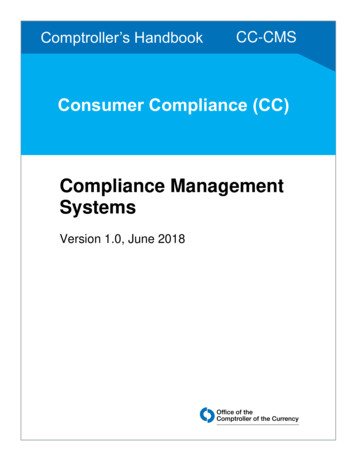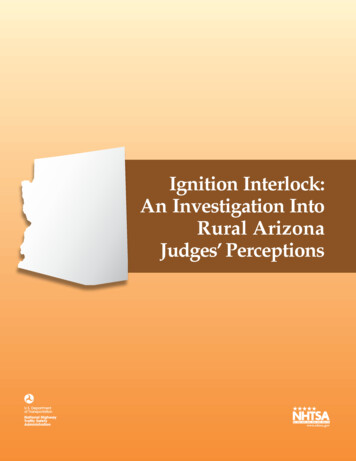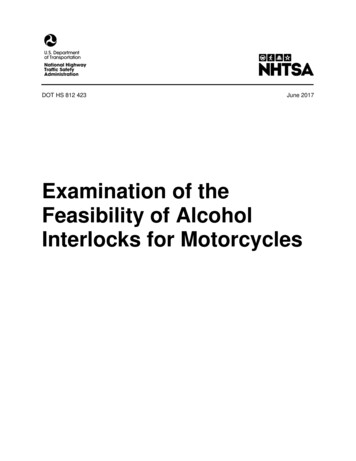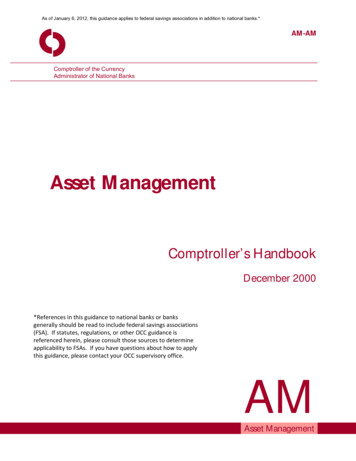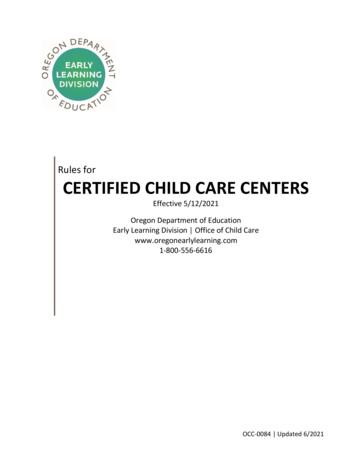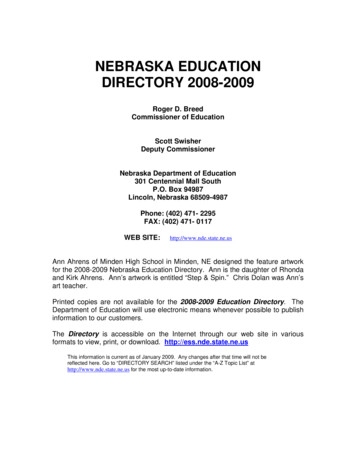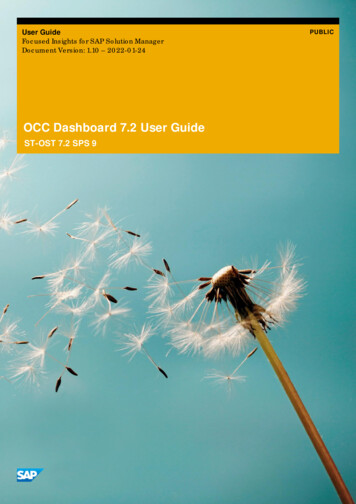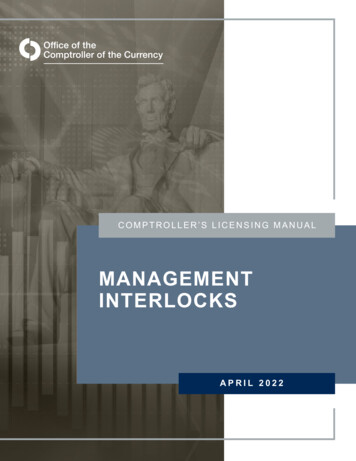
Transcription
COMPTROLLER’S LICENSING MANUALMANAGEMENTINTERLOCKSAPRIL 2022
ContentsContents . iIntroduction . 1Key Policies . 2Prohibitions . 2Exemptions . 2Statutory Exemptions . 2Regulatory Exemptions . 3Background Investigations . 5Decision Criteria . 5Application Process . 6General . 6General Exemption Filings . 6Presumptions of No Adverse Effect on Competition Filings . 7Diversified Savings and Loan Holding Companies . 7Change in Circumstances. 7Additional Information Requests . 8Glossary . 9References . 12Table of Updates Since Publication . 13Comptroller’s Licensing ManualiManagement Interlocks
IntroductionThis booklet of the Comptroller’s Licensing Manual provides guidance concerning thelicensing procedures of the Office of the Comptroller of the Currency (OCC) relating tomanagement interlocks.1 The requirements referred to in this guidance document reflectprovisions in existing statutes and regulations. The relevant statutes and regulations are listedat the end of this booklet or referenced as applicable throughout the document.2Specifically, this booklet explains when a prohibited interlock is created.summarizes interlock exemptions for persons and organizations.outlines the OCC’s filing requirements for persons and organizations seeking interlockexemptions.includes a glossary of terms, a reference section of statutes and regulations, and web linksto sample filing forms.The purpose of the Depository Institution Management Interlocks Act, 12 USC 3201–3208,(Interlocks Act) is to foster competition by generally prohibiting a management official of adepository organization from simultaneously serving as a management official of anunaffiliated depository organization in situations when the management interlock likelywould have an anticompetitive effect.3 There are certain statutory and regulatory exemptionsto these general interlock prohibitions. Some of these exemptions are self-executing. In othercases, the exemption applies only after the OCC approves an application.Banks interested in establishing a management interlock should review the OCC’s regulation,12 CFR 26, before submitting a filing for an interlock exemption.Throughout this booklet, national banks and federal savings associations are referred to collectively as banks,except when it is necessary to distinguish between the two.12This booklet also may include procedures that banks must follow in connection with filing applications andnotices with the OCC. Such procedures are not substantive rules that establish decision criteria. Rather, they aresteps a bank must take in connection with filing an application or notice to allow the OCC to assess whether abank has met the substantive requirements for the application or notice in existing statutes and regulations.Consistent with the Administrative Procedure Act, the OCC may issue guidance concerning licensing that hasbinding procedural steps a bank must take to allow the OCC to assess a bank’s application or notice. See 5 USC553(b)(A).3A “depository organization” is defined as a depository holding company (refer to 12 CFR 26.2(e)) or adepository institution (refer to 12 CFR 26.2(f)). Pursuant to 12 USC 5364, nonbank financial companiessupervised by the Board of Governors of the Federal Reserve System (Federal Reserve) are treated as bankholding companies for purposes of the Interlocks Act.Comptroller’s Licensing Manual1Management Interlocks
Key PoliciesProhibitionsThe Interlocks Act and the OCC’s implementing regulation generally prohibit managementinterlocks in the following three situations, unless the interlock is otherwise exempted: Community prohibition: If both unaffiliated depository organizations, or any of theirdepository institution affiliates, have a principal or branch office in the same community,4they may not have a management interlock regardless of their size.Relevant metropolitan statistical area (RMSA) prohibition: If each unaffiliateddepository organization has total assets of 50 million or more, and both depositoryorganizations, or any of their depository institution affiliates, have offices in the sameRMSA, they may not have a management interlock.Major assets prohibition: If a depository organization has total assets exceeding 10billion, a management official of that organization, or any of its affiliates, may not serveat the same time as a management official of any unaffiliated depository organizationwith total assets exceeding 10 billion, or any affiliate of such depository organization,regardless of their locations. The OCC and the other federal financial regulatoryauthorities may periodically adjust the thresholds for the major assets prohibition bypublishing a final rule in the Federal Register.5ExemptionsStatutory ExemptionsThe Interlocks Act includes several specific exemptions from the general interlocksprohibitions. Under these statutory exemptions (codified in 12 USC 3204 and 3205, andlisted in 12 CFR 26.4), the Interlocks Act permits a management interlock for the followingorganizations and persons: A depository organization that is placed formally in liquidation, under receivership orconservatorship, or in similar circumstances.A corporation operating under section 25 or 25A of the Federal Reserve Act (Edge Actand Agreement Corporations).A credit union being served by a management official of another credit union.A depository organization that does not conduct business in the United States, except asincidental to its activities outside of the United States.A state-chartered savings and loan guaranty corporation.4Principal office for a national bank means its main office. Principal office for a federal savings associationmeans its home office.5The other federal financial regulatory authorities are the Federal Reserve, the Federal Deposit InsuranceCorporation (FDIC), and the National Credit Union Administration (NCUA).Comptroller’s Licensing Manual2Management Interlocks
A Federal Home Loan Bank or any other bank organized solely to serve depositoryinstitutions (for example, a bankers’ bank) or solely to provide securities clearingservices and related services for depository institutions and securities companies.A depository organization that is closed or that the appropriate federal depositoryinstitution’s regulatory authority finds to be in danger of closing and is acquired byanother depository organization. This exemption lasts five years from the date ofacquisition.A diversified savings and loan holding company for which a director servessimultaneously as a director of an unaffiliated depository organization, if (1) both thediversified savings and loan holding company and the unaffiliated depositoryorganization notify their appropriate regulatory agencies at least 60 days beforebeginning the dual service; and (2) the appropriate regulatory agency does not disapprovethe dual service before the end of the 60-day period.Any savings association that has issued stock in connection with a qualified stockissuance pursuant to 12 USC 1467a(q).An otherwise prohibited interlocking relationship with a federal savings association for aperiod of up to 10 years if the FDIC approves such relationship pursuant to12 USC 1823(k)(1)(A)(v).A person whose continuing dual service as a management official of more than onedepository organization began before November 10, 1978.6Regulatory ExemptionsThe Interlocks Act also provides general authority for the OCC to establish other exemptionsthrough its regulations. The OCC has used this authority to establish the small market shareexemption and the general exemption as discussed further below.Small Market Share ExemptionUnder the small market share exemption (12 CFR 26.5), a management interlock involvingtwo unaffiliated depository organizations is permitted if (1) the interlock is not prohibited bythe major assets prohibition;7 and (2) the depository organizations and their depositoryinstitution affiliates hold, in the aggregate, no more than 20 percent of the deposits in eachRMSA or community in which both organizations, or their depository institution affiliates,have offices. OCC approval is not required to claim the small market share exemption.Depository organizations seeking to establish a management interlock relying on the smallmarket share exemption must determine their eligibility by using deposit market share datapublished in the FDIC’s summary of deposits for the RMSA or community.86This statutory exemption is at 12 USC 3205(a); it is not included in the statutory exemptions listed in12 CFR 26.4.7Refer to 12 CFR 26.3(c).8Refer to FDIC, “Bank Data & Statistics, Deposit Market Share Reports,” athttps://www.fdic.gov/bank/statistical/ (June 2021).Comptroller’s Licensing Manual3Management Interlocks
Although no filing with the OCC is required for the small market share exemption, eachdepository organization using this exemption must maintain records to support itsdetermination of eligibility for the exemption and must reconfirm that determinationannually. A bank may meet this record requirement by documenting the determination ofeligibility in the board of directors’ minutes. The OCC confirms the bank’s determination ofeligibility through the supervisory process.The small market share exemption continues to apply as long as the depository organizationsmeet the applicable conditions. Any event (such as an expansion, merger, or growth) thatcauses the level of deposits to exceed 20 percent of the total deposits in an RMSA orcommunity, as applicable, requires the management official to either terminate their serviceor apply to the OCC for an exemption.General ExemptionUnder its general exemption authority (12 CFR 26.6(a)), the OCC may permit an exemptionof an otherwise prohibited management interlock if it finds that the interlock would not resultin a monopoly or substantial lessening of competition and would not present safety andsoundness concerns.To request an exemption for an interlock under the general exemption provision, theapplicant must submit an application to the OCC demonstrating that the proposedmanagement interlock would not result in a monopoly or substantial lessening of competitionand would not present safety and soundness concerns. If the OCC approves the interlockexemption without applying any presumptions (see paragraph below) and without anexpiration date, then the interlock exemption continues as long as the circumstances at thedepository organizations do not change; that is, as long as the interlock would not result in amonopoly, substantial lessening of competition, or an unsafe or unsound condition.Presumption of No Adverse Effect on Competition (12 CFR 26.6(b))When a general exemption is sought, the OCC’s regulations provide that the agency willapply a rebuttable presumption that a management interlock will not result in a monopoly orsubstantial lessening of competition if the depository organization seeking to add themanagement official primarily serves low- and moderate-income areas;is controlled or managed by members of a minority group or women;is a depository institution that has been chartered for less than two years; oris deemed to be in “troubled condition” by the OCC.A bank that intends to rely on one of these presumptions must submit an applicationdemonstrating that (1) the management interlock would not present a safety and soundnessconcern to the bank; and (2) the depository organization fits into one of the four categorieslisted above. The OCC may request any additional information it needs to render its decision.Comptroller’s Licensing Manual4Management Interlocks
If the OCC grants an interlock exemption relying on a presumption listed in 12 CFR 26.6(b),the interlock may continue for three years, unless the OCC specifies otherwise in writing. Abank may file for an extension of such an interlock or, alternatively, use any other exemptionfor which it qualifies.Background InvestigationsThe OCC investigates the character, competence, experience, and integrity of each personwho is the subject of a request for a management interlock exemption. To conductbackground investigations, the OCC requires the bank to submit the biographical portion ofthe Interagency Biographical and Financial Report on the management official creating theinterlock. The OCC may grant a waiver of this requirement if the agency obtains a writtenrecord with sufficient information regarding the management official’s recent managementhistory with a regulated depository institution.If the person is serving as a management official of a state-chartered bank, a state-charteredsavings association, or a credit union, the OCC will contact other financial regulatoryagencies (i.e., the FDIC, the Federal Reserve, the NCUA, or the appropriate state financialregulator) and inquire into that agency’s experience with the proposed management official.Decision CriteriaThe OCC may reject a request for a management interlock exemption under its generalexemption authority, in 12 CFR 26.6(a), if the agency finds that the interlock would result in a monopoly or substantial lessening of competition; orpresent safety and soundness concerns.The OCC may disapprove a notice for a proposed management interlock under thediversified savings and loan holding company exemption, 12 CFR 26.4(h)(2),9 if the agencyfinds that the service cannot be structured or limited so as to preclude an anticompetitive effect infinancial services in any part of the United States;the service would lead to substantial conflicts of interest or unsafe or unsound practices;orthe filer does not furnish all the information the OCC requires.9For more information on diversified savings and loan holding companies, see further discussion on page 8 ofthis booklet.Comptroller’s Licensing Manual5Management Interlocks
Application ProcessGeneralA bank must submit an application to the appropriate OCC licensing office for a generalexemption under 12 CFR 26.6(a). A statutory exemption involving a diversified savings andloan holding company requires filing a notice with the appropriate OCC licensing officeunder 12 CFR 26.4(h)(1)(i). After determining that sufficient information is provided, theOCC makes its decision on the management interlock filing.General Exemption FilingsA bank filing an application for a general exemption must include the following information: Identity (name, position) of all management officials to whom the filing pertains and thefull legal name and home office/headquarters of the depository organizations the officialsserve or propose to serve.The biographical portion of the Interagency Biographical and Financial Report on themanagement official creating the interlock, unless the OCC grants a waiver because ofrecent management experience in another depository institution. Refer to the“Background Investigations” booklet of the Comptroller’s Licensing Manual.A description of the product lines, geographic locations, market areas, and principalcompetitors for each affected depository organization. Specifically identify any productlines or market areas in which the depository organizations compete.Market share data, such as the Herfindahl-Hirschman Indexes (HHI), and otherinformation demonstrating that the interlock will not result in a monopoly or substantiallessening of competition. This information also should include any expansion, merger, orgrowth plans of either depository organization that could have anticompetitive effects orcause decreased competition or increased market overlap in any of the affected marketareas or product lines.Information regarding any other interlocks among the affected depository organizations.Information demonstrating that the interlock would not adversely affect the bank’s safetyand soundness.If applicable, copies of filings and/or information regarding the status of any interlockexemption request submitted to any other federal or state banking agency.Certification that the bank’s board of directors, shareholders, or a designated official haveauthorized the filing of the application.Generally, the entity for which the individual proposes to commence service as amanagement official (and, thus, create the interlock) would file the request for a generalexemption.Comptroller’s Licensing Manual6Management Interlocks
Presumptions of No Adverse Effect on Competition FilingsA bank that seeks an exemption under the OCC’s general exemption authority and believes itfits within one of the presumptions set forth in 12 CFR 26.6(b) must submit an applicationwith all relevant information, as set forth in the “General Exemption Filings” section of thisbooklet, but the bank may exclude an analysis on competitive factors. In addition, theapplication should include information demonstrating that the bank primarily serves low- and moderate-income areas;is controlled or managed by women or minorities or both;has been chartered for less than two years; oris in “troubled condition” as defined in 12 CFR 5.51(c)(7).Diversified Savings and Loan Holding CompaniesA bank filing a notice for an exemption pursuant to 12 CFR 26.4(h) must include theinformation required under the “General Exemption Filings” section and informationdemonstrating the following: The holding company in question is diversified as defined in the Home Owners’ LoanAct and implementing regulations.The interlock would not cause an anticompetitive effect in financial services in any partof the United States.The interlock would not lead to substantial conflicts of interest. The filing should includeinformation concerning any relationships or transactions between the diversified savingsand loan holding company and its subsidiaries and the subject depository organization.The interlock would not lead to unsafe or unsound practices.Each entity involved in the proposed interlock must file a notice with its appropriate federalbanking agency.Change in CircumstancesPursuant to 12 CFR 26.7, a management official must terminate their service with adepository organization or apply for an exemption if a change in circumstances causes theservice to become a prohibited management interlock. Depository organizations must addressthe prohibited interlock within 15 months of the change or such shorter period as the OCCdirects. The following changes in circumstances may cause a previously permissibleinterlock to become prohibited: An increase in an organization’s asset size. Refer to the discussion of asset size in the“Prohibitions” section of this booklet;A change in the delineation of the RMSA or community resulting in the samemanagement official serving two depository organizations in the same RMSA orcommunity;Comptroller’s Licensing Manual7Management Interlocks
The establishment of an office resulting in the same management official serving twodepository organizations in the same RMSA or community;An increase in the aggregate deposits of the depository organization. Refer to thediscussion of small market share in the “Regulatory Exemptions” section of this booklet;orAn acquisition, a merger, a consolidation, or any reorganization of the ownershipstructure of a depository organization. Refer to the “Business Combinations” booklet ofthe Comptroller’s Licensing Manual.Pursuant to 12 CFR 26.4(h)(3), the OCC may require that any interlock permitted by thediversified savings and loan holding company exemption be terminated if a change incircumstances occurs with respect to one of the interlocked depository organizations thatwould have provided a basis for disapproval of the interlock during the notice period.Additional Information RequestsThe OCC notifies the filer whether additional information is required to make the decisionand includes a due date for response. The OCC may disapprove an application if theapplicant does not provide the requested information.If the filer cannot submit the additional information on or before the deadline, it shouldcontact the OCC as soon as possible. Generally, the OCC considers a filing abandoned if theadditional information is not received within 30 days. At that time, the OCC notifies the filerthat the OCC has stopped processing the filing.Comptroller’s Licensing Manual8Management Interlocks
GlossaryAffiliate: An affiliate of a depository institution, as defined in 12 USC 3201(3), generally isany company controlled by the same stockholders, including members of the sameimmediate family, who control the depository organization. Refer to 12 USC 3201(3) and12 CFR 26.2(a) for the complete definition of an affiliate.Anticompetitive effect: A monopoly or substantial lessening of competition.Area median income: The median family income for the metropolitan statistical area (MSA)in which a depository organization is located or the statewide nonmetropolitan median familyincome if the depository organization is outside an MSA.Community: A city, town, or village, and contiguous or adjacent cities, towns, or villages.Contiguous or adjacent cities, towns, or villages: Cities, towns, or villages whose borderstouch each other or whose borders are within 10 road miles of each other at their closestpoints. The property line of an office in an unincorporated city, town, or village is theboundary line of that city, town, or village.Depository holding company: A bank holding company or a savings and loan holdingcompany whose principal office is in the United States. Generally, a company qualifies as adepository holding company if it owns, controls, or has power to vote at least 25 percent ofthe voting shares of a bank or savings association; controls the election of a majority ofdirectors or trustees of the bank or savings association; or otherwise is found to exercise acontrolling influence over the management or policies of the bank or savings association. Adepository holding company also includes a company that would be a bank holding companyas defined in 12 USC 1841(a) but for the exemption in 12 USC 1841(a)(5)(f) and a nonbankfinancial company supervised by the Federal Reserve.Depository institution: A commercial bank, a savings bank, a trust company, a savings andloan association, a building and loan association, a homestead association, a cooperativebank, an industrial bank, or a credit union chartered under the laws of the United States andwhose principal office is in the United States. Additionally, a branch or agency office of aforeign commercial bank in the United States is a depository institution.Depository institution affiliate: A depository institution that is an affiliate of a depositoryorganization.Depository organization: A depository institution or a depository holding company.Diversified savings and loan holding company: Any savings and loan holding companywhose subsidiary savings association and related activities as permitted under12 USC 1467a(c)(2) represented, on either an actual or a pro forma basis, less than50 percent of its consolidated net worth at the close of its preceding fiscal year and of itsconsolidated net earnings for such fiscal year.Comptroller’s Licensing Manual9Management Interlocks
Immediate family: A spouse, mother, father, child, grandchild, sister, brother, or any of theirspouses, whether or not any of their shares are held in trust. Shares held by a person includeshares held by members of their immediate family.Interlock: An interlock exists when a management official simultaneously serves twounaffiliated depository organizations.Low- and moderate-income area: A census tract (or, if an area is not in a census tract, ablock numbering area delineated by the U.S. Bureau of the Census) in which the medianfamily income is less than 100 percent of the area median income.Management official: For Interlocks Act purposes, a management official includes a seniorexecutive officer, as that term is defined in 12 CFR 5.51(c)(4) (see senior executive officer),a director, an advisory or honorary director of a depository institution with total assets of 100 million or more, a branch manager, a trustee of a depository organization under thecontrol of trustees, and any person who has a representative or nominee serving in any ofthose capacities. The term “management official” does not include a person whosemanagement functions relate exclusively to the business of retail merchandising ormanufacturing, a person whose management functions relate principally to the businessoutside the United States of a foreign commercial bank, or a person described in the provisosof section 202(4) of the Interlocks Act (12 USC 3201(4)) (referring to an officer of a statechartered savings bank, cooperative bank, or trust company that neither makes real estatemortgage loans nor accepts savings).Newly chartered institution: An institution that has been chartered for less than two yearsfrom the time it files a request for exemption.Office: A principal or branch office of a depository institution in the United States, but not arepresentative office of a foreign commercial bank, an electronic terminal, or a loanproduction office.Relevant metropolitan statistical area (RMSA): An MSA, a primary MSA, or aconsolidated MSA that is not composed of designated primary MSAs to the extent theseterms are defined and applied by the Office of Management and Budget.Representative or nominee: A natural person who serves as a management official and hasan obligation to act on behalf of another person with respect to management responsibilities.Senior executive officer: A president, chief executive officer, chief operating officer, chieffinancial officer, chief lending officer, chief investment officer, and any other person theOCC identifies in writing to the bank who exercises significant influence over, or participatesin, major policymaking decisions of the bank without regard to title, salary, or compensation.The term also includes employees of entities retained by a bank to perform such functions inlieu of directly hiring the persons, and, with respect to a federal branch operated by a foreignbank, the person functioning as the chief managing official of the federal branch. Refer to 12CFR 5.51(c)(4).Comptroller’s Licensing Manual10Management Interlocks
Total assets: Assets measured on a consolidated basis and reported in the most recent fiscalyear-end consolidated reports of condition and income. Note that for diversified savings andloan holding companies, total assets include only the assets of the depository institution. Fora foreign bank, total assets include only assets of its U.S. branch or agency. Refer to12 CFR 26.2(o) for a complete definition of total assets.Troubled condition: A bank is designated to be in troubled condition if it (1) has acomposite CAMELS rating of 4 or 5;10 (2) is subject to a cease-and-desist order, a consentorder, or a formal written agreement, unless otherwise informed in writing by the OCC; or(3) has been informed in writing by the OCC that, based on information pertaining to suchbank, it has been designated in troubled condition.10A bank’s composite rating under the Uniform Financial Institutions Rating System, or CAMELS, integratesratings from six component areas: capital adequacy, asset quality, management, earnings, liquidity, andsensitivity to market risk.Comptroller’s Licensing Manual11Management Interlocks
ReferencesChanges in Directors and Senior Executive OfficersLawRegulation12 USC 1831i12 CFR 5.51Depository Institution Management Interlocks ActLaw12 USC 3201–3208Regulation12 CFR 26Dodd–Frank Wall Street Reform and Consumer Protection ActLaw12 USC 5364Home Owners’ Loan ActLawComptroller’s Licensing Manual12 USC 1467a12Management Interlocks
Table of Updates Since PublicationDate of Last Publication: January 2017ReasonAffected pagesReflect change to major assets prohibition threshold2Comptroller’s Licensing Manual13Management Interlocks
explains when a prohibited interlock is created. summarizes interlock exemptions for persons and organizations. outlines the OCC's filing requirements for persons and organizations seeking interlock exemptions. includes a glossary of terms, a reference section of statutes and regulations, and web links to sample filing forms.

